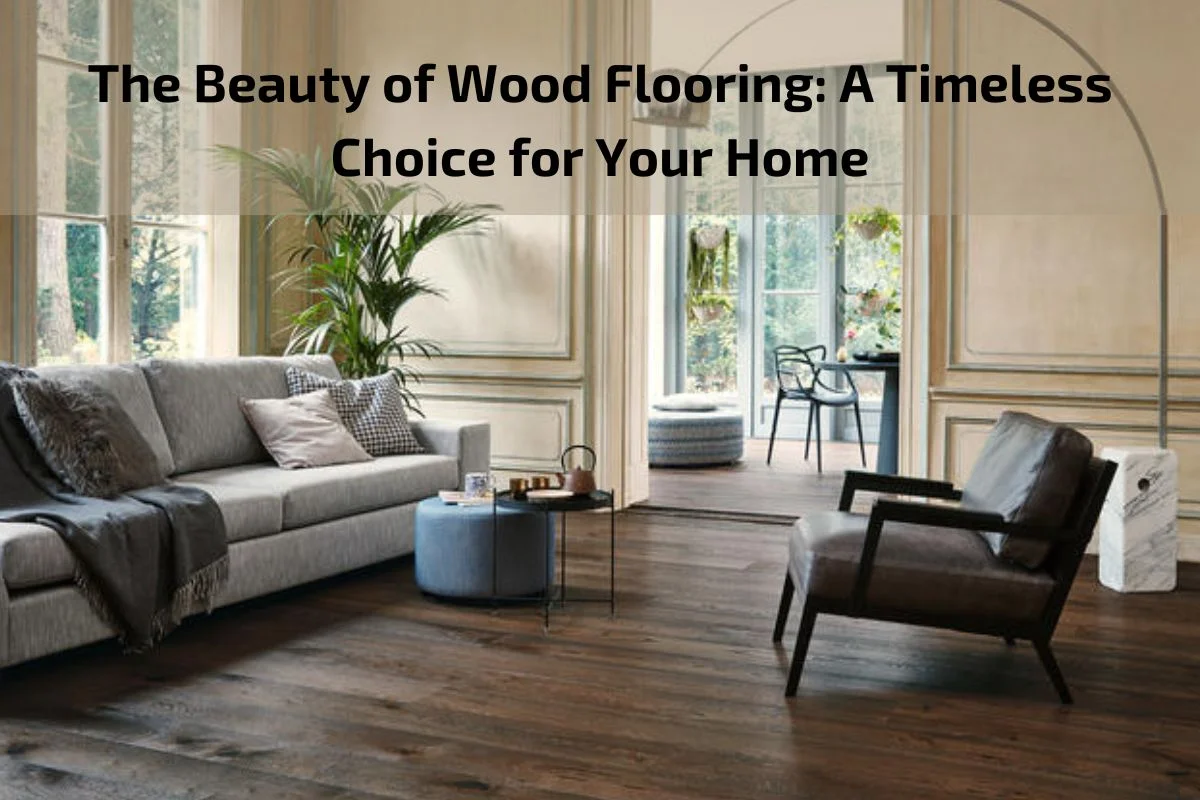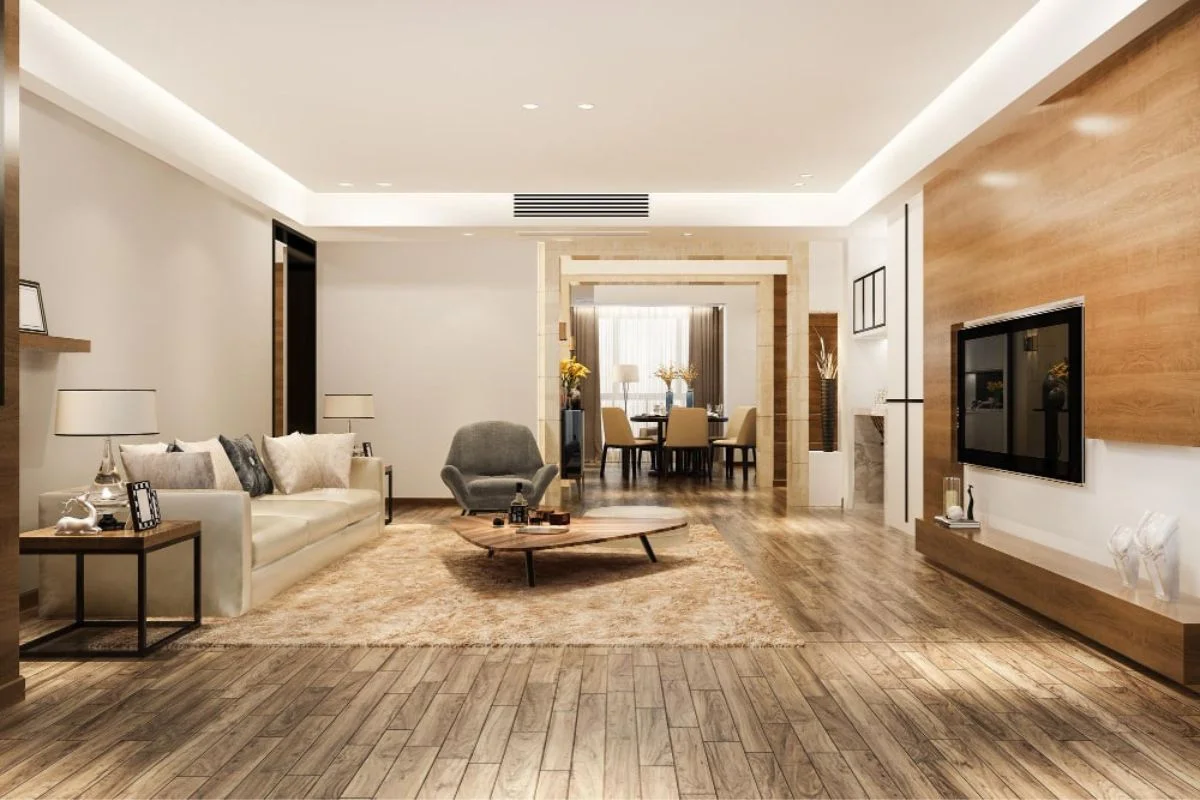
Wood flooring exudes a timeless charm and elegance that has captivated homeowners for centuries. From its natural warmth and beauty to its durability and versatility, wood flooring remains a beloved choice for enhancing the aesthetics and ambiance of any home. Whether you prefer the classic appeal of hardwood, the modern convenience of engineered wood, or the affordability of laminate, wood flooring offers a range of options to suit every style and budget.
In this exploration of the beauty of wood flooring, we’ll delve into the unique characteristics and benefits that make it a timeless choice for your home. From its rich history and sustainability to its ability to add warmth and character to any space, wood flooring has an enduring appeal that transcends trends and fads.
Join us as we celebrate the beauty of wood flooring and discover why it continues to be a preferred option for homeowners around the world. Whether you’re renovating your entire home or simply updating a single room, wood flooring has the power to transform your space into a welcoming and inviting retreat that you’ll cherish for years to come. Let’s embark on a journey through the enchanting world of wood flooring, where beauty meets durability and tradition meets innovation
The Beauty of Wood Flooring:
Wood flooring embodies a timeless elegance that has captivated homeowners and designers for centuries. Its natural warmth, character, and versatility make it a cherished choice for enhancing the aesthetic appeal of any space, from traditional to contemporary.
Rich History and Tradition: Wood flooring has a rich history steeped in tradition and craftsmanship. Dating back to ancient times, wood has been prized for its beauty and durability, gracing the floors of palaces, castles, and stately homes throughout history. This heritage adds a sense of timelessness and sophistication to any interior.
Natural Warmth and Character: Unlike artificial flooring materials, wood flooring exudes a warm and inviting ambiance that cannot be replicated. Each plank tells a unique story, with distinct grain patterns, knots, and variations in color and texture that add character and charm to every room. Whether it’s the rustic allure of reclaimed barn wood or the refined elegance of oak or maple, wood flooring brings a sense of authenticity and connection to nature into the home.
Versatility in Design: One of the most appealing aspects of wood flooring is its versatility in design. From traditional hardwoods like oak and cherry to exotic species such as teak and mahogany, wood flooring offers a wide range of options to suit any aesthetic preference or decor style. Whether you prefer the classic elegance of wide-plank hardwoods or the modern allure of engineered wood or laminate, there’s a wood flooring option to complement any interior design scheme.
Timeless Appeal: Wood flooring transcends trends and fads, retaining its timeless appeal decade after decade. Unlike other flooring materials that may come in and out of fashion, wood flooring remains a classic choice that never goes out of style. Its enduring beauty and longevity make it a wise investment that adds value and sophistication to any home.
Types of Wood Flooring:
Wood flooring comes in a variety of types, each with its own unique characteristics, benefits, and considerations. Understanding the different types of wood flooring can help you choose the best option for your home based on factors such as style, durability, and budget. Here are the main types of wood flooring:
Solid Hardwood Flooring:
- Solid hardwood flooring is made from a single piece of hardwood lumber, typically 3/4 inch thick.
- It is available in a wide range of wood species, including oak, maple, cherry, and walnut, each with its own distinct grain patterns and colors.
- Solid hardwood can be sanded and refinished multiple times, making it a durable and long-lasting flooring option.
- However, it is susceptible to moisture and temperature changes, so it may not be suitable for areas with high humidity or below-grade installations.
Engineered Wood Flooring:
- Engineered wood flooring consists of multiple layers of wood veneer bonded together with adhesive and topped with a thin layer of hardwood.
- This construction makes engineered wood more stable and resistant to moisture and temperature fluctuations than solid hardwood.
- Engineered wood can be installed in areas where solid hardwood may not be suitable, such as basements or bathrooms.
- It comes in a variety of wood species, finishes, and plank sizes, offering versatility in design and style options.
Laminate Wood Flooring:
- Laminate wood flooring is composed of a core layer of high-density fiberboard (HDF) or plywood with a photographic layer of wood grain pattern and a protective wear layer on top.
- It mimics the look of real wood at a lower cost and is highly durable, scratch-resistant, and easy to clean.
- Laminate flooring is available in a wide range of styles, colors, and finishes, including wood grain patterns, stone, and tile designs.
- While laminate flooring cannot be sanded or refinished like hardwood, it is a budget-friendly option for homeowners seeking the look of wood flooring without the expense.
Vinyl Wood Flooring:
- Vinyl wood flooring, also known as luxury vinyl plank (LVP) or luxury vinyl tile (LVT), replicates the look of wood with high-resolution printing technology.
- It is constructed of multiple layers, including a wear layer, a photographic layer, and a core layer for stability and water resistance.
- Vinyl wood flooring is highly durable, waterproof, and easy to maintain, making it suitable for high-traffic areas and moisture-prone spaces like kitchens and bathrooms.
- It comes in a variety of styles, colors, and textures, including realistic wood grain patterns and embossed textures for added authenticity.
Bamboo Flooring:
- Bamboo flooring is made from the fast-growing bamboo plant, which is harvested and processed into planks for flooring.
- It is a sustainable and eco-friendly option due to bamboo’s rapid renewal rate and minimal environmental impact.
- Bamboo flooring is durable, stable, and moisture-resistant, making it suitable for a variety of environments.
- It comes in a range of colors and styles, from natural blonde to darker carbonized shades, and can be installed using various methods such as floating, nail-down, or glue-down.
Choosing the Right Wood Flooring for Your Home:
When it comes to selecting wood flooring for your home, there are several factors to consider to ensure you make the right choice. From the type of wood species to the style and finish, each decision plays a significant role in the overall look, durability, and functionality of your flooring. Here are some key considerations to help you choose the right wood flooring for your home:
Consider the Room: Different rooms in your home have different needs and requirements when it comes to flooring. For high-traffic areas like entryways, hallways, and living rooms, durable hardwood or engineered wood flooring may be the best choice. For moisture-prone areas like kitchens, bathrooms, and basements, consider waterproof options like vinyl or tile wood flooring.
Evaluate Lifestyle and Usage: Take into account your lifestyle and how the room will be used when choosing wood flooring. If you have children or pets, you’ll want a flooring option that can withstand scratches, spills, and everyday wear and tear. Hardwood flooring with a durable finish or scratch-resistant laminate may be suitable for busy households.
Wood Species and Color: Different wood species offer varying grain patterns, colors, and hardness levels. Consider the aesthetic appeal and durability of different wood species when choosing flooring for your home. Oak and maple are popular choices for their durability and versatility, while exotic species like Brazilian cherry or acacia offer unique grain patterns and colors.
Style and Finish: Wood flooring comes in a variety of styles and finishes, from traditional smooth finishes to distressed, hand-scraped, or wire-brushed textures. Consider the style of your home and personal preferences when choosing the finish of your wood flooring. Matte finishes offer a more natural and rustic look, while glossy finishes provide a sleek and contemporary feel.
Budget and Cost: Wood flooring costs can vary significantly depending on the type of wood species, quality, and installation method. Solid hardwood flooring tends to be more expensive than engineered wood, laminate, or vinyl options. Consider your budget and long-term investment when choosing the right wood flooring for your home.
Installation and Maintenance: Consider the ease of installation and maintenance when choosing wood flooring. Some options, like click-lock engineered wood or laminate flooring, offer easy DIY installation, while others may require professional installation. Additionally, consider the maintenance requirements of different wood flooring options and choose one that fits your lifestyle and maintenance preferences.
Enhancing Your Home with Wood Flooring: Design Tips and Inspiration
Wood flooring has the power to transform the look and feel of your home, adding warmth, elegance, and character to any space. Whether you’re renovating a room or building a new home, incorporating wood flooring into your design can create a beautiful and inviting environment. Here are some design tips and inspiration to help you enhance your home with wood flooring:
Create Visual Interest with Patterns: Consider using wood flooring to create eye-catching patterns and designs that add visual interest to your space. Whether it’s a classic herringbone pattern, a timeless chevron design, or a contemporary geometric layout, patterned wood flooring can elevate the style and sophistication of any room.
Mix and Match Wood Species: Experiment with mixing different wood species and finishes to create contrast and dimension in your home. Combining light and dark woods, or mixing smooth and textured finishes, can add depth and richness to your flooring design, making it more visually dynamic and engaging.
Define Spaces with Wood Flooring: Use wood flooring to define different areas within an open-concept floor plan. Transitioning between rooms or zones with different wood flooring can help delineate spaces and create a sense of continuity and flow throughout your home. Consider using a border or transition strip to visually separate areas while maintaining a cohesive look.
Layer with Area Rugs: Enhance the comfort and style of your wood flooring by layering with area rugs. Area rugs add warmth, texture, and color to your space while protecting wood flooring from scratches and wear. Choose rugs that complement your flooring and decor style, whether it’s a vibrant Persian rug, a cozy shag rug, or a sleek, modern design.
Incorporate Wood Accents: Extend the beauty of wood flooring beyond the floors by incorporating wood accents throughout your home. From wood trim and baseboards to built-in cabinetry and furniture, integrating wood elements into your interior design creates a cohesive and harmonious look that enhances the overall aesthetic appeal of your space.
Balance with Neutral Colors: Balance the richness and warmth of wood flooring with neutral colors on walls, furniture, and decor. Soft, neutral hues like white, beige, and gray provide a clean and timeless backdrop that allows the natural beauty of wood flooring to shine while creating a sense of balance and harmony in your home.
Optimize Natural Light: Maximize the impact of wood flooring by optimizing natural light in your home. Position furniture and accessories strategically to allow sunlight to highlight the natural grains and textures of your flooring, creating a warm and inviting atmosphere that enhances the overall ambiance of your space.
Embrace Contrast: Embrace contrast in your design by pairing light wood flooring with dark furniture and accents, or vice versa. Contrasting elements create visual interest and drama, adding depth and dimension to your space while highlighting the beauty of your wood flooring.
Blend Indoor and Outdoor Spaces: Extend the beauty of wood flooring beyond the confines of your home by seamlessly transitioning to outdoor spaces like patios, decks, or porches. Using the same or complementary wood flooring materials indoors and outdoors creates a cohesive and harmonious connection between indoor and outdoor living areas, enhancing the overall flow and continuity of your home.
Personalize with Finishing Touches: Personalize your wood flooring design with finishing touches that reflect your unique style and personality. Whether it’s custom inlays, borders, or medallions, incorporating personalized details adds a touch of luxury and individuality to your flooring design, making it truly your own.
Maintaining and Caring for Your Wood Flooring:
Wood flooring is a timeless investment that adds beauty and value to your home. Proper maintenance and care are essential to ensure that your wood floors retain their natural beauty and durability for years to come. Here are some tips for maintaining and caring for your wood flooring:
Regular Cleaning Routine:
- Sweep or vacuum your wood floors regularly to remove dirt, dust, and debris that can scratch the surface.
- Use a damp mop or microfiber cloth dampened with a mild hardwood floor cleaner to clean spills and stains promptly.
- Avoid using excessive water or harsh cleaning products, as they can damage the wood and finish.
Protective Measures:
- Place doormats at entryways to prevent dirt and grit from being tracked onto your wood floors.
- Use felt pads or furniture glides on the legs of furniture to prevent scratches and dents when moving or rearranging furniture.
- Use area rugs or runners in high-traffic areas and under furniture to provide additional protection and reduce wear.
Preventative Maintenance:
- Trim pets’ nails regularly to prevent scratches on wood floors.
- Avoid wearing high heels or shoes with sharp or spiked heels on wood floors, as they can cause dents and scratches.
- Use rugs or mats in kitchens and dining areas to protect wood floors from spills and stains.
Maintain Proper Humidity Levels:
- Wood flooring is sensitive to changes in humidity, which can cause it to expand and contract.
- Maintain indoor humidity levels between 30% to 50% to prevent excessive expansion or contraction of wood floors.
- Use a humidifier during dry winter months and a dehumidifier during humid summer months to regulate indoor humidity levels.
Routine Maintenance Tasks:
- Inspect wood floors regularly for signs of wear, damage, or discoloration.
- Buff or recoat wood floors periodically to refresh the finish and restore luster.
- Sand and refinish wood floors as needed to repair scratches, dents, or deep stains.
Avoid Common Mistakes:
- Do not use abrasive cleaners, ammonia-based products, or wax-based polishes on wood floors, as they can damage the finish.
- Do not use steam mops or wet mops on wood floors, as excessive moisture can cause warping and cupping.
- Avoid dragging heavy furniture or sharp objects across wood floors, as they can scratch or gouge the surface.
Professional Maintenance:
- Schedule professional wood floor cleaning and maintenance services periodically to deep clean and revitalize your wood floors.
- Consult with a professional wood flooring contractor for advice on proper maintenance and care techniques for your specific type of wood flooring.
Maintaining and Caring for Your Wood Flooring:
Wood flooring is not only a beautiful addition to any home but also an investment that requires proper care and maintenance to retain its allure and longevity. Whether you have hardwood, engineered wood, or laminate wood flooring, implementing a regular cleaning and maintenance routine is essential to keep your floors looking their best. Here’s a comprehensive guide on how to maintain and care for your wood flooring:
Daily Cleaning Routine:
Start by sweeping or vacuuming your wood floors daily to remove dirt, dust, and debris. Use a soft-bristled broom or a vacuum with a hardwood floor attachment to prevent scratches.
- For spot cleaning, use a slightly dampened microfiber cloth or mop to wipe away spills and stains promptly. Avoid using excess water, as it can damage the wood.
Weekly Maintenance:
- Once a week, clean your wood floors with a hardwood floor cleaner recommended by the manufacturer. Dilute the cleaner according to the instructions and mop the floors in the direction of the wood grain.
- Avoid using harsh chemicals, ammonia-based cleaners, or abrasive cleaning tools, as they can strip away the finish and damage the wood.
Preventative Measures:
- Place doormats at entryways to trap dirt, grit, and moisture from shoes before they reach your wood floors. Consider using rugs or runners in high-traffic areas to provide additional protection.
- Use felt pads or furniture glides on the legs of furniture to prevent scratches and dents when moving or rearranging furniture. Avoid dragging heavy objects across the floor.
Protecting Against Moisture:
- Wood flooring is susceptible to moisture damage, so it’s essential to clean up spills immediately and avoid excessive moisture on the floors.
- Use a humidifier during dry winter months to maintain indoor humidity levels between 30% to 50%. Excessively dry air can cause wood floors to shrink and crack.
- In humid environments, use a dehumidifier to reduce moisture levels and prevent warping, cupping, or buckling of the wood.
Regular Inspections:
- Inspect your wood floors regularly for signs of wear, damage, or discoloration. Look for scratches, dents, or areas where the finish may be wearing thin.
- Address any issues promptly by spot treating stains, buffing out scratches, or applying touch-up finish as needed. For deeper scratches or damage, consult with a professional wood flooring contractor.
Professional Maintenance:
- Schedule professional wood floor cleaning and maintenance services annually or as needed to deep clean and revitalize your floors.
- Professional services may include buffing, recoating, or refinishing the floors to restore their original luster and beauty.
Long-Term Care:
- With proper care and maintenance, wood flooring can last for decades, adding value and beauty to your home. Protect your investment by implementing a regular cleaning routine and addressing any issues promptly.
Conclusion:
Proper maintenance and care are essential to preserving the beauty and longevity of your wood flooring. By implementing a regular cleaning routine, taking preventative measures to protect against scratches and moisture, and addressing any issues promptly, you can ensure that your wood floors remain a stunning and durable feature of your home for years to come.



